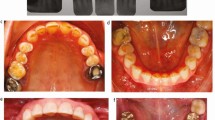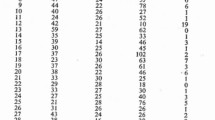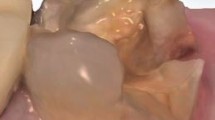Key Points
-
A restrospective longevity study performed at a mixed general practice.
-
The first study that provides evidence about the direct wax technique for indirect restorations.
-
The proposed technique is highly successful in a general practice environment.
Abstract
Background and objectives Compared to other restoration types, indirect cast posterior restorations of partial coverage exhibit one of the longest survivals. The purpose of the current study was to estimate the success rates of 'direct-wax' cast gold onlays. According to the direct wax technique, the wax pattern is shaped intra-orally followed by direct casting without the need for impressions, resulting in low cost and short processing time.
Design and methods A retrospective survival study was undertaken at a mixed National Health Service and private general dental practice based in London. Patients with direct-wax onlays attending over a period of four months for regular check-ups or dental treatment were recruited. Patient discomfort, pain or sensitivity was recorded. Restoration location, extension, marginal fit, and tooth vitality were also recorded. Restoration failure was defined in the event of recurrent caries, pulp infection for vital teeth, increase in the size of periapical radiolucency for non-vital teeth, and restoration decementation. Survival estimates were calculated using the Kaplan-Meier algorithm.
Result One hundred and ninety-four onlays in 56 patients were examined. Four restorations (2.1%) had failed, mainly due to recurrent caries. The cumulative survival probability was estimated at 415.3 (95% Confidence Interval: 403.0, 427.7) months (34.6, 95% CI: 33.6, 35.6 years), while the 10-year and 20-year survival rates were 97.0% and 94.1% respectively. Vital teeth, compared to non-vital ones, and onlay extension encompassing both the mesial and distal tooth surfaces exhibited significantly (P <0.05) higher success rates. Variations in marginal fit and restoration location did not affect the survival probability.
Conclusion Direct-wax cast gold restorations of partial coverage were a highly successful treatment option for posterior restorations in a general dental practice environment.
Similar content being viewed by others
Log in or create a free account to read this content
Gain free access to this article, as well as selected content from this journal and more on nature.com
or
References
Manhart J, Chen H, Hamm G, Hickel R . Buonocore Memorial Lecture. Review of the clinical survival of direct and indirect restorations in posterior teeth of the permanent dentition. Oper Dent 2004; 29: 481–508.
Pjetursson B E, Sailer I, Zwahlen M, Hämmerle C H . A systematic review of the survival and complication rates of all-ceramic and metal-ceramic reconstructions after an observation period of at least 3 years. Part I: Single crowns. Clin Oral Implants Res 2007; 18: 73–85.
Schwartz N L, Whitsett L D, Berry T G, Stewart J L . Unserviceable crowns and fixed partial dentures: life-span and causes for loss of serviceability. J Am Dent Assoc 1970; 81: 1395–401.
Walton J N, Gardner F M, Agar J R . A survey of crown and fixed partial denture failures: length of service and reasons for replacement. J Prosthet Dent 1986; 56: 416–421.
Cheung G S. A preliminary investigation into the longevity and causes of failure of single unit extracoronal restorations. J Dent 1991; 19: 160–163.
Stoll R, Sieweke M, Pieper K, Stachniss V, Schulte A . Longevity of cast gold inlays and partial crowns – a retrospective study at a dental school clinic. Clin Oral Investig 1999; 3: 100–104.
Studer S P, Wettstein F, Lehner C, Zullo T G, Schärer P . Long-term survival estimates of cast gold inlays and onlays with their analysis of failures. J Oral Rehabil 2000; 27: 461–472.
Smales R J, Hawthorne W S . Long-term survival of extensive amalgams and posterior crowns. J Dent 1997; 25: 225–227.
Reeh E S, Messer H H, Douglas W H . Reduction in tooth stiffness as a result of endodontic and restorative procedures. J Endod 1989; 15: 512–516.
Bentley C, Drake C W . Longevity of restorations in a dental school clinic. J Dent Educ 1986; 50: 594–600.
Smales R J, Hawthorne W S . Long-term survival of repaired amalgams, recemented crowns and gold castings. Oper Dent 2004; 29: 249–253.
Kelly P G, Smales R J . Long-term cost-effectiveness of single indirect restorations in selected dental practices. Br Dent J 2004; 196: 639–643.
Mjor I A, Medina J E . Reasons for placement, replacement, and age of gold restorations in selected practices. Oper Dent 1993; 18: 82–87.
Jokstad A, Mjor I A, Qvist V . The age of restorations in situ. Acta Odontol Scand 1994; 52: 234–242.
Donovan T, Simonsen R J, Guertin G, Tucker R V . Retrospective clinical evaluation of 1,314 cast fold restorations in service from 1 to 52 years. J Esthet Restor Dent 2004; 16: 194–204.
Acknowledgements
The authors would like to thank Dr Grammati Sarri for her invaluable help regarding the statistical procedures, and Dr Bobby Bandlish and Dr Gita Auplish for their useful comments about the study design and text editing.
Author information
Authors and Affiliations
Corresponding author
Additional information
Refereed paper
Rights and permissions
About this article
Cite this article
Bandlish, L., Mariatos, G. Long-term survivals of 'direct-wax' cast gold onlays: a retrospective study in a general dental practice. Br Dent J 207, 111–115 (2009). https://doi.org/10.1038/sj.bdj.2009.668
Accepted:
Published:
Issue date:
DOI: https://doi.org/10.1038/sj.bdj.2009.668
This article is cited by
-
Survival of direct resin composite onlays and indirect tooth-coloured adhesive onlays in posterior teeth: a systematic review
British Dental Journal (2022)
-
Efficient, high quality
British Dental Journal (2009)



